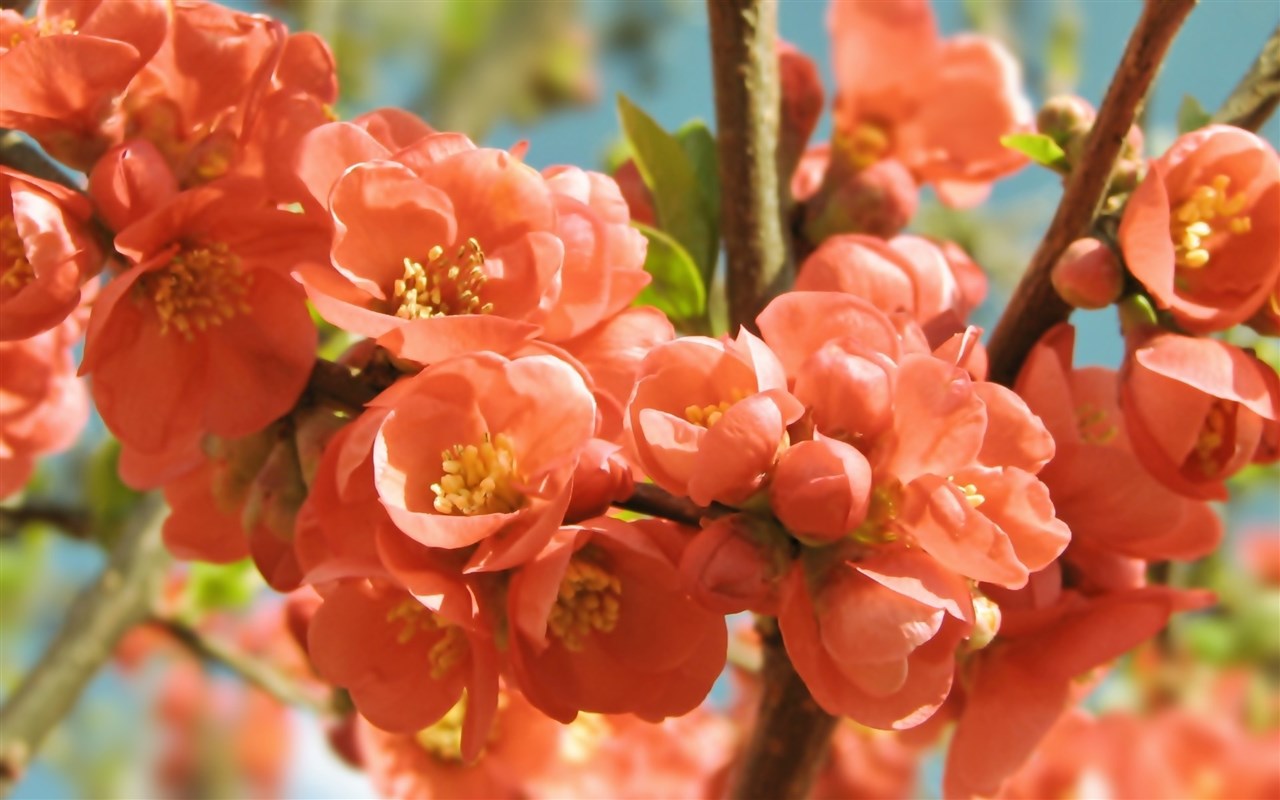A Celebration of Color: Unveiling Spring’s Floral Tapestry
Ah, spring! The season of rebirth and renewal when the world awakens from its winter slumber, bursting forth in a vibrant display of color and fragrance. It’s the time when flower buds, eager to show off, push through the thawing ground, painting the landscape with nature’s artistry. But these aren’t just pretty faces; spring flowers carry stories, whispered through the ages, of hope, joy, and enduring love. Let’s delve into this world of petals and discover what makes these blooms so captivating.
Spring’s Star Performers: A Closer Look at Beloved Blooms
Imagine stepping into a garden brimming with spring’s finest. You might encounter:
-
Tulips: These showstoppers come in a dazzling spectrum of colors, from fiery reds and sunny yellows to the softest pinks and purples. Standing tall and proud, tulips embody joy and everlasting love—nature’s ultimate romantic gesture.
-
Daffodils: If sunshine had a mascot, it would undoubtedly be the daffodil. These trumpet-shaped beauties, painted in cheerful hues of yellow and white, practically announce, “Spring is here!” They represent new beginnings and the promise of brighter days.
-
Hyacinths: These charmers captivate our senses with their intoxicating fragrance. Their sweet, floral scent, impossible to resist, fills the air with the joy of being alive. Hyacinths, with their clusters of bell-shaped blooms in vibrant blues, pinks, and purples, add drama and elegance to any garden.
-
Crocuses: Talk about making a grand entrance! Crocuses are among the first brave souls to emerge as winter’s grip begins to loosen. These small but mighty blooms, often peeking out from beneath melting snow, paint the ground with splashes of purple, yellow, and white, reminding us that even after the coldest, darkest times, life finds a way.
-
Pansies: With their velvety petals and “faces” formed by their unique markings, pansies exude personality. These charming flowers, like little love letters from the garden, symbolize fond memories and enduring affection.
-
Violets: Don’t let their delicate appearance fool you; violets possess a quiet strength and charm. Their subtle beauty adds a touch of elegance to any garden, representing loyalty, faithfulness, and enduring love.
Cultivating Spring’s Splendor: Tips for a Flourishing Garden
Ready to create your own springtime oasis? Here are some insider tips to ensure your flowers thrive:
-
Right Plant, Right Place: Just like you wouldn’t wear a swimsuit to a snowstorm, different flowers have different needs. Some bask in the sun, while others prefer a cool, shady retreat. Do your research and select plants that will feel right at home in your garden’s unique environment.
-
The Soil Situation: Nourishing soil is crucial for healthy plants. Just as we need nutritious food, flowers need nutrient-rich soil to thrive. Amending your soil with organic matter improves drainage and provides essential nutrients—it’s like a spa day for plant roots!
-
Timing is Key: Fall or early spring is the ideal time for planting most spring-blooming bulbs. This allows them to establish roots before the grand performance begins.
-
Let the Sunshine In: Most spring flowers are sun-worshippers, relying on those golden rays to reach their full potential. Aim for at least six hours of direct sunlight each day for optimal growth and blooms.
-
Water Wisely: Consistent moisture is essential, but don’t drown your plants! Aim for a gentle soaking, allowing the water to penetrate the roots without waterlogging the soil. And don’t forget the plant food! A balanced fertilizer, applied during the growing season, provides essential nutrients for abundant blooms.
-
The Art of Deadheading: While it may seem counterintuitive, removing faded flowers, known as deadheading, encourages new growth. This redirects the plant’s energy from seed production to producing more blooms.
Beyond the Bloom: Delving into Culture and Symbolism
Spring flowers are more than just pretty faces; they hold deep cultural and symbolic meaning passed down through generations.
-
Daffodils: In Wales, these golden trumpets represent national pride, worn on St. David’s Day, a celebration of Welsh culture and heritage.
-
Tulips: The Netherlands, famous for its colorful tulip fields, has a long-standing love affair with these elegant blooms. They hold a special place in Dutch culture, symbolizing romance, new beginnings, and the arrival of spring.
-
Pansies: In the Victorian era, a time of subtle communication, pansies, with their diverse colors and patterns, were used to convey secret messages. A yellow pansy might express, “You occupy my thoughts,” while a purple whispered, “I have thoughts of you.”
A Celebration of Life’s Simple Joys
Spring flowers are more than just plants; they are a vibrant reminder that even after the harshest winters, beauty finds a way to emerge. So, take a moment to appreciate these seasonal wonders, whether strolling through a garden, receiving a thoughtful bouquet, or cultivating your own little patch of springtime magic. They are a gift, encouraging us to embrace joy, nurture hope, and find delight in the wonders of the natural world.
Blooming Beyond: Unlocking the Secrets to “What Flower is Known for Spring?”
To truly outshine the competition and claim a top spot in search results, you need a captivating and comprehensive approach:
Recommended Titles:
Instead of simply listing flowers, pique your reader’s curiosity with these engaging titles:
- More Than Just a Pretty Face: Unveiling the True Flower of Spring
- Why the [Your Top Contender, e.g., Tulip] DESERVES to be Called THE Spring Flower
- From Ancient Myths to Modern Gardens: The Enduring Story of Spring’s Most Iconic Bloom
Powerful Key Lines:
Weave these compelling phrases into your article to capture your reader’s attention and highlight key points:
- [Flower Name]: A Symbol of Spring’s Promise. (Connects the flower to a universal emotion)
- From [Country] to [Country], the [Flower]’s Global Impact Speaks Volumes. (Emphasizes the flower’s widespread appeal)
- [Flower Name]: Nature’s Own Herald of Spring’s Arrival. (Positions the flower as a key indicator of seasonal change)
- Beyond the Garden: Exploring the [Flower]’s Influence on Art, Culture, and Beyond. (Hints at the flower’s broader significance)
Structured Content and Important Details:
I. The Top Contenders: A Data-Driven Approach
Present your research on the most popular “spring flowers.”
- Tulips: Highlight their global presence in festivals and gardens, emphasizing their association with renewal and new beginnings.
- Daffodils: Quantify their early arrival, emphasizing their resilience and association with joy and sunshine.
- Other Strong Contenders: Conduct in-depth analyses of hyacinths, crocuses, and other potential candidates, highlighting their unique characteristics and cultural significance.
II. Beyond Popularity: Defining the Essence of a “Spring” Flower
Go beyond simply listing popular flowers and delve into the factors that make a flower truly emblematic of spring:
-
Scientific Factors:
- Photoperiodism: Explain how day length triggers blooming in spring flowers.
- Temperature Sensitivity: Discuss which flowers are most responsive to the first signs of warmth.
-
Cultural Significance: Explore the rich history and symbolism associated with spring flowers, including:
- Myths and Legends: Uncover fascinating folklore surrounding various blooms.
- Art and Literature: Analyze how artists and writers have used spring flowers to evoke emotions and symbolism.
III. The Case for YOUR Chosen Flower: Building a Compelling Argument
This is where you present your unique perspective, making a strong case for why your chosen flower reigns supreme.
- Gather Strong Evidence: Use data, historical references, cultural examples, and scientific insights to support your claims.
- Illustrate, Don’t Just State: Instead of simply saying “tulips represent spring,” provide specific examples like, “Amsterdam’s annual Tulip Festival, attracting millions of visitors, celebrates the vibrant arrival of spring.”
Unique Insights and Untapped Potential:
- Climate Change Angle: Explore how shifting weather patterns might be affecting the blooming times of traditional “spring” flowers.
- Beyond the “Pretty”: Discuss the flower’s role in the ecosystem, including its interactions with pollinators and its potential benefits or drawbacks.
- Local Focus: While aiming for broad appeal, tailor some content to your audience’s region, highlighting local flowers and their connection to spring.
Remember: Instead of simply listing flowers, craft a captivating narrative that immerses your reader in the world of spring blooms. By combining thorough research, engaging storytelling, and a unique perspective, you’ll create an article that stands out from the competition and keeps readers engaged.
Outperforming Your Competition: A Deep Dive into “What are the five flowers that bloom in spring season?”
To create a truly outstanding article, it’s essential to analyze your competition and identify opportunities to provide unique value and insights. Here’s how:
Recommended Titles:
Go beyond basic list-style titles and use keywords strategically to capture reader interest:
- Beyond the Basics: 5 Unique Spring Flowers to Transform Your Garden
- First Signs of Spring: 5 Early Blooming Flowers and How to Grow Them
- 5 Spring Flowers That Will Attract Pollinators and Bring Your Garden to Life
Powerful Key Lines:
Use these attention-grabbing phrases to pique your reader’s curiosity and highlight the key benefits of your article:
- Spring’s Arrival, in Full Bloom: Discover 5 Flowers That Embody the Season. (Creates a sense of excitement and anticipation)
- From Dainty Snowdrops to Vibrant Tulips: A Tapestry of Color and Renewal. (Emphasizes the visual beauty and transformative power of spring flowers)
- More Than Just Pretty Faces: These 5 Spring Bloomers Support a Thriving Ecosystem. (Highlights the ecological importance of your chosen flowers)
- Unlock the Secrets of a Flourishing Spring Garden with These 5 Must-Have Plants. (Offers practical advice and appeals to gardening enthusiasts)
Important Details for Your Article: A Comprehensive Guide
I. Introduction:
- Hook: Start with a captivating anecdote, a vivid description of spring, or a thought-provoking question to draw your reader in.
- Keyword Relevance: Clearly state that your article will introduce five captivating flowers that bloom in spring.
- Set Yourself Apart: Briefly mention that your article will go beyond basic lists, offering a deeper understanding of these flowers and their unique qualities.
II. The Five Flowers: In-Depth Spotlights
Dedicate a separate section to each flower, providing comprehensive information and engaging descriptions:
- Flower Name (Common and Scientific): Use both common and scientific names for clarity and SEO.
- Visual Appeal: Include high-quality, captivating images that showcase the flower’s beauty.
- Distinctive Characteristics: Describe the flower’s color, bloom time, size, shape, and fragrance (if applicable).
- Growing Conditions: Provide detailed information on sunlight requirements, soil type, watering needs, and hardiness zones.
- Unique Features and Interesting Facts: Share intriguing details about the flower’s history, symbolism, pollinator interactions, medicinal uses, or any other noteworthy characteristics.
- Gardening Tips: Offer practical advice on planting, care, maintenance, pest control, and disease prevention.
III. Conclusion:
- Recap and Summarize: Briefly restate the key features and benefits of each flower.
- Call to Action: Encourage readers to plant these flowers in their gardens, learn more about supporting pollinators, or share their favorite spring blooms.
IV. Additional Sections for Enhanced Value:
- Early, Mid, and Late Spring Bloomers: Provide a categorized list or table for easy reference.
- Spring Flower Arrangement Ideas: Offer inspiring ideas for bouquets, centerpieces, and other decorative uses.
- The Ecological Role of Spring Flowers: Expand on their importance for pollinators and the food web.
Unique Insights and Untapped Potential:
-
Spotlight Less-Common Beauties: Instead of focusing on the usual suspects (tulips, daffodils), consider featuring less well-known but equally stunning spring flowers like bleeding hearts, Virginia bluebells, or epimediums.
-
Engage the Senses: Go beyond visuals and describe the sweet fragrances, delicate textures, and even the sounds associated with your chosen flowers.
-
Connect with Current Trends: Incorporate popular gardening trends like pollinator-friendly planting, native plant choices, and sustainable practices.
Remember: Don’t plagiarize content. Use this information as inspiration to conduct your own research and create an original, insightful, and engaging article.
Mastering the “What is the First Flower of Spring Called?” Search Results
To outrank the competition and provide exceptional value to your readers, you need a multi-faceted approach that combines research, storytelling, and strategic SEO:
Competitor Title Analysis and Recommendations:
- Analyze Existing Titles: Identify common themes, keywords, and approaches used by your competitors.
- Craft Titles That Stand Out: Use your analysis to craft titles that are both informative and intriguing, enticing readers to click.
Consider these options:
- Beyond the Crocus: Unveiling the True First Flowers of Spring (Hints at lesser-known blooms)
- When Spring Whispers: The Earliest Flowers to Greet the Season (Poetic and evocative)
- Before the Tulips Rise: Exploring Early Spring’s Hidden Floral Gems (Establishes a hierarchy and promises unique discoveries)
Powerful Key Lines: Captivate Your Readers
Weave these compelling phrases into your article to highlight key information and evoke emotion:
- [Specific Flower Name, e.g., Star Magnolia]: Often Claiming the Title of Spring’s Frontrunner. (Directly answers the keyword question)
- Ephemeral Beauties Like Bloodroot and Dutchman’s Breeches Steal the Show in Early Spring Woodlands. (Highlights the fleeting nature and unique habitats of certain flowers)
- Forget the Calendar, the Emergence of [Flower Name] Signals Spring’s True Arrival. (Connects the flower to a tangible, relatable event)
- From the Subtle Hues of [Flower] to the Vibrant [Color] of [Flower]: Early Spring Offers a Breathtaking Floral Prelude. (Paints a vivid picture and emphasizes diversity)
Structured Content and Important Details: Organize for Clarity and SEO
A. Defining “First”: Acknowledge the Nuances
* Geographic Variation: Emphasize that the “first” flower varies by location, altitude, and microclimate.
* Cultivated vs. Wild: Distinguish between garden favorites and wildflowers in your examples.
* The “First” Debate: Mention that no single flower holds the universal title, creating intrigue.
B. Spotlight on a Key Contender: Star Magnolia (Magnolia stellata)
* Blooming Time: Highlight its very early bloom time, often while other plants are still dormant.
* Appearance: Describe its unique characteristics, such as its large, soft-pink flowers.
* Growing Conditions: Mention its preference for sunny to partly shaded areas with well-drained soil.
C. Spring Ephemerals: The Underdog Champions
* Definition: Explain the term “ephemeral,” highlighting their short lifespans and connection to early spring.
* Examples: Showcase a variety of ephemeral wildflowers and their unique features:
* Bloodroot (Sanguinaria canadensis)
* Dutchman’s Breeches (Dicentra cucullaria)
* Virginia Bluebells (Mertensia virginica)
* Trout Lily (Erythronium americanum)
* Ecological Importance: Explain their vital role as early nectar sources for pollinators.
D. People’s Statements: Connect with Personal Experiences
* Incorporate Quotes or Anecdotes: Use quotes from gardeners or nature enthusiasts to connect with your audience. For example: “‘A sure sign of spring in my area is when the bloodroot blooms.'”
IV. Unique Insights and Untapped Potential: Go Beyond the Basics
- Microclimate Focus: Explore how “first” blooms can differ even within a small area due to varying conditions.
- Climate Change Impact: Research how shifting temperatures might be affecting traditional bloom times.
- Early Bloomers for Gardeners: Offer tips on selecting and planting early-flowering species.
- Photography Tips: Provide advice on capturing the beauty of these fleeting blooms.
V. Additional Resources: Provide Credible Sources
* Local Botanical Gardens and Arboretums: Suggest contacting these organizations for local “first bloom” records.
* Citizen Science Projects: Reference relevant projects tracking bloom times to show the dynamic nature of this phenomenon.
Remember: Combine thorough research, captivating storytelling, and a strategic approach to create an informative and engaging article that ranks highly and provides exceptional value to your readers.
- White Kitchen With Butcher Block Countertops: A Warm, Inviting Design - January 4, 2026
- Marble Countertops Prices: What Impacts the Overall Cost to Install? - January 3, 2026
- Marble Countertops Cost: What Factors Impact the Total Price? - January 2, 2026










